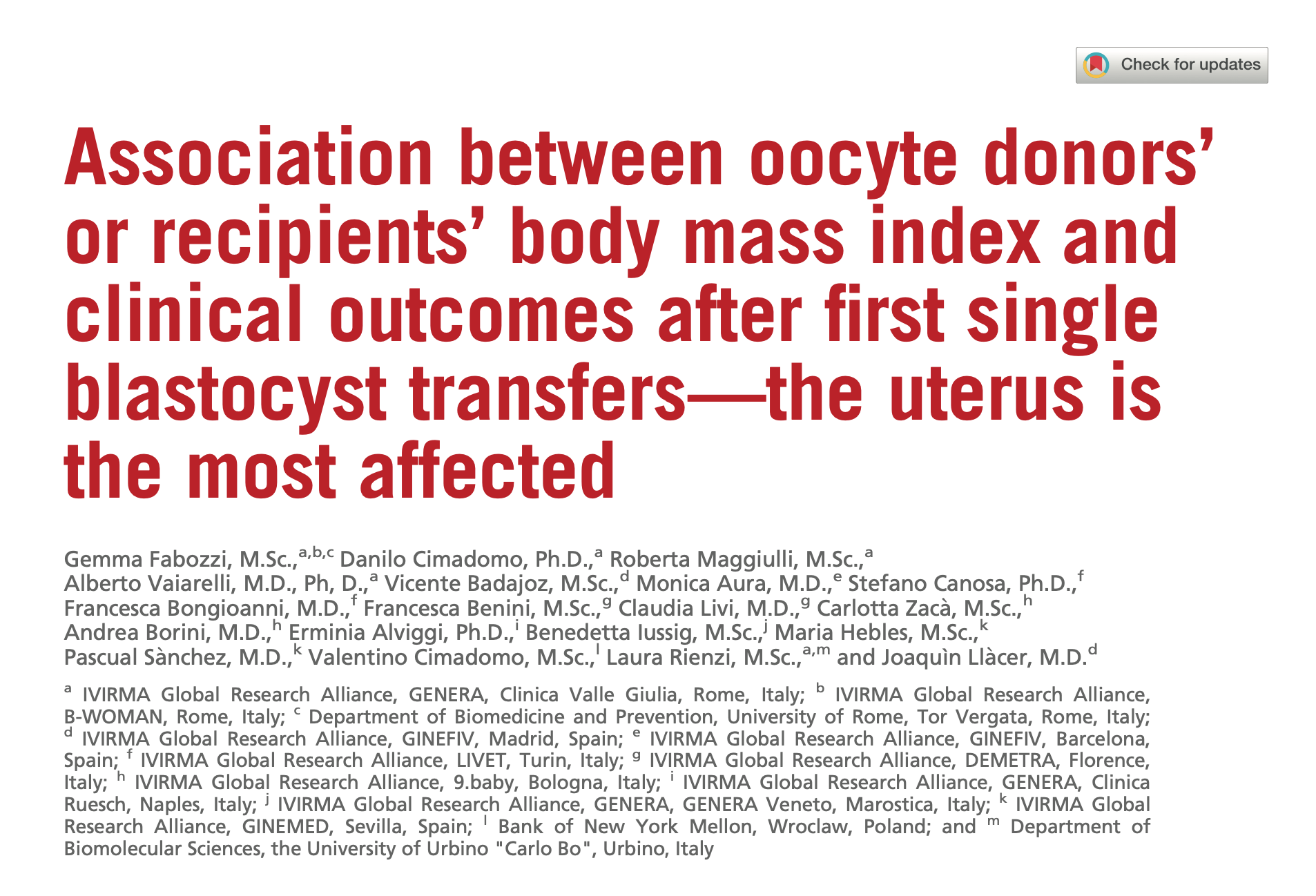
Gemma Fabozzi, Danilo Cimadomo, Roberta Maggiulli, Alberto Vaiarelli, Vicente Badajoz, Monica Aura, Stefano Canosa, Francesca Bongioanni, Francesca Benini, Claudia Livi, Carlotta Zaca, Andrea Borini, Erminia Alviggi, Benedetta Iussig, Maria Hebles, Pascual Sanchez, Valentino Cimadomo, Laura Rienzi, and Joaquìn Llacer
Fertility and Sterility® Vol. 121, No. 2, February 2024 https://doi.org/10.1016/j.fertnstert.2023.07.029 – Received February 28, 2023; revised July 26, 2023; accepted July 28, 2023; published online August 5, 2023
Abstract
Objective: To assess whether high body mass index (BMI) in either oocyte donors or recipients is associated with poorer outcomes after the first single blastocyst transfer.
Design: Retrospective study including 1,394 first blastocyst single embryo transfers (SETs) conducted by 1,394 recipients during oocyte donation cycles with the gametes retrieved from 1,394 women (January 2019-July 2021). Four BMI clusters were defined for both donors and recipients (underweight: <18.5 kg; normal weight: 18.5-24.9 kg; overweight: 25-29.9 kg; and obese: ≥30 kg).
Setting: Network of private IVF centers.
Patients: A total of 1,394 recipients aged 42.4 ± 4.0 and with a BMI of 23.2 ± 3.8 kg/m2, and 1,394 donors aged 26.1 ± 4.2 and with a BMI of 21.9 ± 2.5 kg/m2.
Intervention: All oocytes were vitrified at 2 egg banks and warmed at 8 in vitro fertilization clinics that were part of the same network. Intracytoplasmic sperm injection, blastocyst culture, and either fresh or vitrified-warmed SETs were conducted. Putative confounders were investigated, and the data were adjusted through regression analyses.
Main outcome measures: The primary outcome was the live birth rate (LBR) per SET according to donors’ and/or recipients’ BMI. The main secondary outcome was the miscarriage rate (<22 gestational weeks) per clinical pregnancy.
Results: The LBR per blastocyst SET showed no significant association with donors’ BMI. Regarding recipients’ BMI, instead, the multivariate odds ratio was significant in obese vs. normal-weight recipients (0.58, 95% confidence interval, 0.37-0.91). The miscarriage rate per clinical pregnancy was also significantly associated with recipients’ obesity, with a multivariate odds ratio of 2.31 (95% confidence interval, 1.18-4.51) vs. normal-weight patients. A generalized additive model method was used to represent the relationship between predicted LBR or miscarriage rates and donors’ or recipients’ BMI; it pictured a scenario where the former outcome moderately but continuously decreases with increasing recipients’ BMI to then sharply decline in the BMI range of 25-35 kg/m2. The miscarriage rate, instead, increases almost linearly with respect to both donors’ and recipients’ increasing BMI.
Conclusion: Obesity mostly affects the uterus, especially because of higher miscarriage rates. Yet, poorer outcomes can be appreciated already with a BMI of 25 kg/m2 in both oocyte donors and recipients. Finer markers of nutritional homeostasis are therefore desirable; recipients should be counseled about poorer expected outcomes in cases of overweight and obesity; and oocyte banks should avoid assigning oocytes from overweight donors to overweight and obese recipients.
Keywords: BMI; miscarriage; obesity; oocyte donation; overweight.
